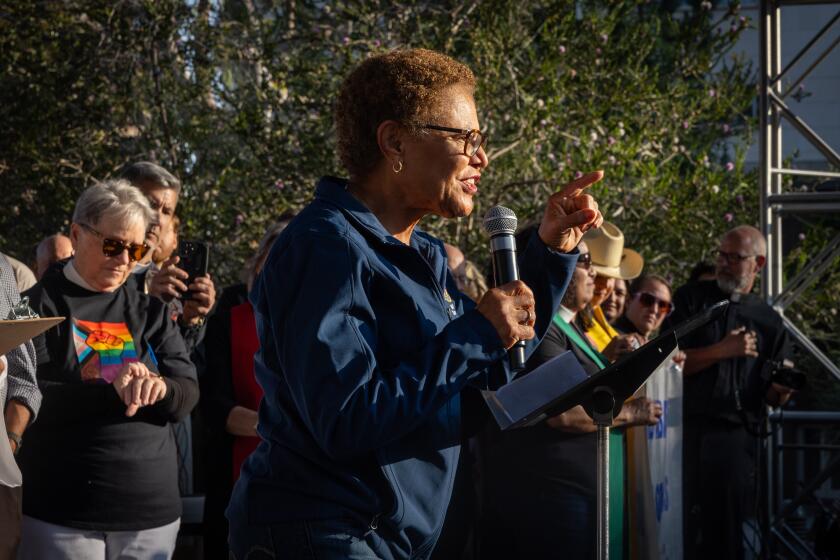‘Dumping’ may land S.F. in court
- Share via
San Bernardino County officials vowed Thursday not to become a dumping ground for San Francisco criminals, saying they may sue that city for exporting juvenile offenders to local group homes.
“The county is exploring every option to recoup all our police expenses,” said county Supervisor Gary Ovitt. “This lunacy needs to stop now.”
Ovitt, joined by other officials at a news conference in San Bernardino, expressed anger over recent revelations that San Francisco sent illegal immigrant cocaine dealers from Honduras to group homes in Yucaipa. Eight juveniles walked away from the homes. One was recaptured in San Francisco this week, and the others remain at large.
Officials in San Francisco acknowledged sending the recent group of Hondurans and said others had been transported down in the past. They are still trying to determine exactly how many.
“San Francisco has a legal and moral obligation to notify us, and they didn’t,” said Michelle Scray, assistant chief probation officer for San Bernardino County. “We have requested a list from San Francisco of any other offenders placed in our county. They assured us they would not be sending any more.”
For years, San Francisco, a sanctuary city since 1989, has been shielding juvenile offenders from federal authorities, either escorting them to their home countries at city expense or transporting them to group homes, including locations in San Bernardino County.
Mayor Gavin Newsom reversed the policy Wednesday saying minors in the country illegally who commit crimes will be turned over to immigration authorities.
The city has spent $2.3 million to house 162 illegal immigrant youths since 2005, and an additional $38,955 to fly juvenile offenders to Honduras, American Samoa and Mexico over the last two years, the mayor said.
“In no uncertain terms, the mayor has directed city officials to stop sending undocumented immigrants to other counties,” said Nathan Ballard, Newsom’s communications director, via e-mail.
Public Defender Jeff Adachi said there are currently no undocumented juveniles from San Francisco in San Bernardino County.
Of the 70 such offenders his office has represented since February 2007, seven have been transported back to their home countries. The other 63 have gone to group homes, foster homes or other facilities -- most in the Bay Area -- and none have been rearrested, he said.
If an offender from San Francisco does escape from a group home or other facility, the Juvenile Court is notified and issues a statewide warrant for the person’s arrest, Adachi said. Warrants were issued for the San Bernardino County escapees.
William Siffermann, chief of San Francisco’s Juvenile Probation Department, acknowledged serious shortcomings in notifying other localities.
“We are aware of state requirements and seek to conform in all matters. We certainly recognize our deficiency in this area,” he said. “We’ve got kids sitting in our placements in San Francisco that come from other counties, and we haven’t received notice. It’s no excuse. In practice we recognize our need to improve.”
He denied that San Bernardino County was a dumping ground for San Francisco problems.
“We sought this venue based on our belief in its rehabilitative value to the dispositional orders entered by the court,” he said.
San Bernardino County Sheriff’s Capt. Bart Gray said his station had received “hundreds” of calls for service at the nine group homes in Yucaipa, including many at Douglas House, where some of the Hondurans were living.
From Jan. 1 to June 30, he received 229 calls from the homes about issues as varied as arson and juveniles running away. In one case, two teenagers from a group home allegedly carjacked and kidnapped a Stater Bros. employee before dumping him in Los Angeles. He survived the attack.
The Honduran runaways weren’t the first San Francisco drug dealers at Douglas House, he said.
Last year a school resource officer tipped off police to four young men from Douglas House who had enrolled in a local school and had a history of cocaine dealing.
“It was the exact same situation we just had,” Gray said. “Ten days after they arrived, they were gone.”
In fact, 60% to 70% of Yucaipa’s group home residents are from outside the county, Gray said.
Group homes and halfway houses have proliferated in the Inland Empire, where real estate is often cheaper than in other counties. Rialto alone has 44 such homes.
“We cannot refuse a group home, and we cannot shut them down,” said Mike Story, director of development services in Rialto. “If a home is licensed as a group home, they tell us where it is but not who is in it. That’s as much as we know.”
The facilities are governed by a complex web of regulations and overseen by the Community Care Licensing Division of the California Department of Social Services. Calls to its Sacramento office were not returned Thursday.
San Bernardino County Dist. Atty. Michael Ramos said his office has the highest criminal caseload in the state and he doesn’t need any more.
“They are dumping people here without telling us who, what, when and where,” he said. “Historically, San Bernardino County was a dumping ground, but in the last few years that has not been the case. I don’t want to go back to the past.”
Douglas House is owned by Silverlake Youth Services, which runs other homes in the Inland Empire. Scray, of county Probation, said she has had “issues” with Silverlake but would not elaborate.
Zachary Fox, Silverlake chief executive officer and an ordained minister, did not return calls seeking comment.
--
--
maria.laganga@latimes.com
More to Read
Sign up for Essential California
The most important California stories and recommendations in your inbox every morning.
You may occasionally receive promotional content from the Los Angeles Times.













